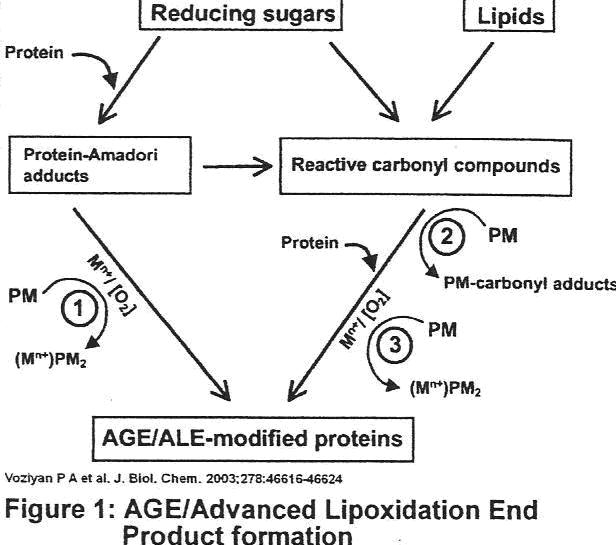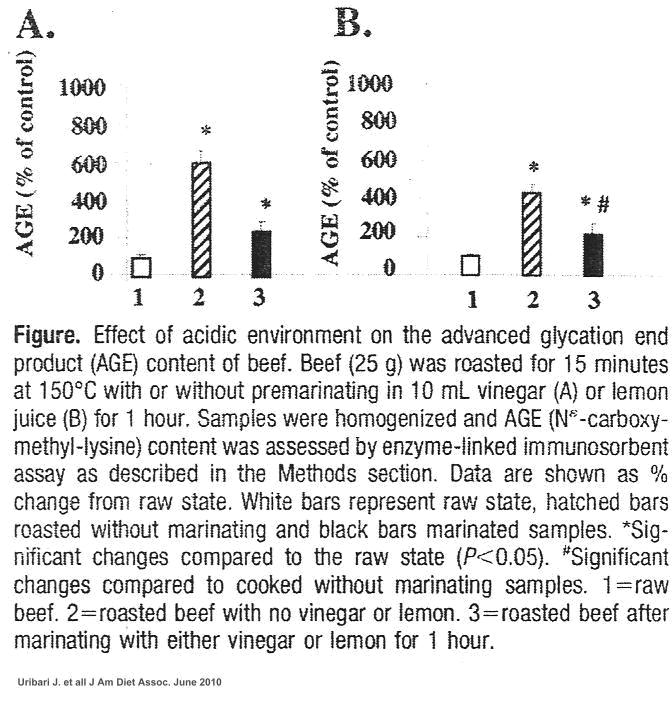



Loading

We analyzed the very high incidence of Insulin Resistant Syndrome (Type 2 Diabetes) of older Californian Viet Kieu previously in this Forum and identified the high amount of dietary Advanced Glycation End products (dAGEs) in Vietnamese cooking as a possible major factor for the discrepancy observed in other Asian-American populations in California. We would like to further explore this important issue and hopefully come up with useful recommendations to address the problem.
What are dAGEs and why are they so bad for your health?
Advanced Glycation End products (AGEs) are created through a non-enzymatic reaction between reducing sugars (fructose, glucose 6 phosphate) and free amino groups of proteins or lipids which is commonly known as the Maillard or browning reaction.
(See Figure 1)
This reaction can occur normally in the body but when it reaches high levels it becomes toxic due to its severe oxidative stress and promoting inflammation on the tissue such as what is observed in patients with untreated Type 2 Diabetes. AGEs such as N-carboxylmethyl-lysine (CML) and methyl-glyoxal (MGO) have been studied extensively in recent years for their role in the pathology of insulin resistant syndrome, atherosclerosis, kidney disease and dementia.
The major source of circulating AGEs in human comes from dietary intake. Cooking with dry heat at high temperature for a prolonged period of time with added simple sugar and/or fat generates a large amount of dAGEs. About 30% of dAGEs is absorbed during ingestion and may stay in the body to cause havoc because of poor renal clearance. Nuong (Grill, Broil) and Kho are two common Vietnamese cooking techniques that can generate an enormous amount of harmful dAGEs; Kho, in particular, is a technique in which raw proteins come into contact with simple sugar during the browning reaction at high temperature (caramelization). As far as dAGEs and health are concerned, it is a recipe for disaster.
Lower dAGEs intake in mice prevents vascular and kidney damage, improves insulin sensitivity and accelerates wound healing. Restriction of dAGEs extends the life span of mice similar to what is observed with calorie restriction. Potentially, lower dAGEs intake in humans may result in similar benefits.
Strategies to lower the consumption of dAGEs for Viet Kieu:
The following techniques have been shown to lower the cooking related AGEs formation:
1-Cook in moist heat: Steaming, boiling, simmering, braising or poaching.
2-Reduce cooking time.
3-Lower cooking temperature.
4-Cook using microwave.
5-Marinate meats (including fish and soy tofu) in acidic milieu, such as vinegars or lemon juice prior to cooking.
(See Figure 2)
Viet Kieu should always marinate their food well in an acidic ingredient prior to Nuong while limiting the additional oil and sugar in the recipes as much as possible. As for Kho, Viet Kieu may have to change the process by adding brown food coloring product at the end of cooking instead of caramelizing sugar at the outset.
Another possible option is using substances like aminoguanidine (being studied) or cinnamon (a spice) that would inhibit or neutralize AGEs formation and/or toxicity.
Summary
Chronic diseases are major causes of disability and frailty in old age. Recent evidence suggests older Viet Kieu to be highly prone to chronic diseases, especially Insulin Resistant Syndrome (Type 2 Diabetes). We believe excess dAGEs generated by Vietnamese cuisine plays a major role in the discrepancy among Asian-Americans. Lowering dAGEs by modifying cooking techniques may benefit all Viet Kieu in the long run.
Pham H Liem, MD
Professor of Geriatrics, Donald W. Reynolds Department of Geriatrics, College of Medicine at UAMS and Associate Chief of Staff for Geriatrics and Extended Care, at CAVHS
Tài liệu tham khảo thêm:
"Separate American and British controlled studies already showed similar results. This latest one is Canadian, albeit a population cohort observational study, with enough statistical power to come up with the same conclusion. Meanwhile, the makers of various fancy "new" insulin products, together with glucose meter manufacturers are "stacking the deck" of various medical "expert" panels to issue confusing and conflicting "consensus" statements to protect their economic interests. Unless the NIH convenes a consensus conference soon, we may be witnessing a major medical scandal of the 21st century with many unsuspecting patients being harmed." more>
https://blogs.consumerreports.org/health/2010/02/is-tight-control-of-type-2-diabetes-too-risky.html
https://www.bmj.com/content/338/bmj.b800.full
Diễn Đàn Cựu Sinh Viên Quân Y
© 2010
© 2010




